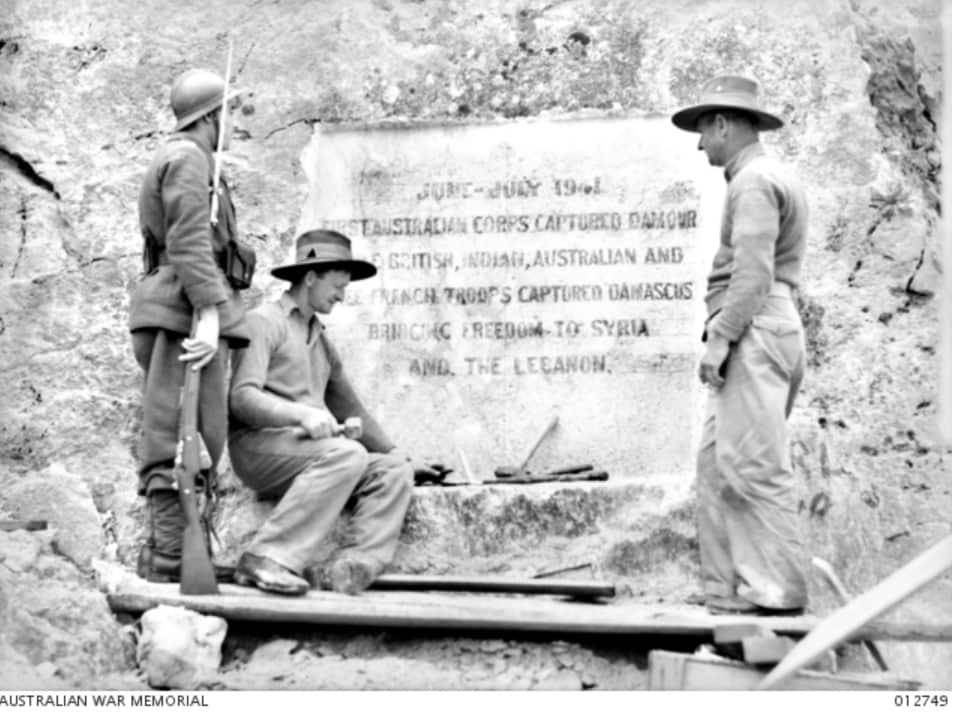In 1941, the Australian army’s 7th Division - along with a coalition of British, Free French, Indian, Czech, and Arab Legion forces - liberated Lebanon and Syria from the Nazi-aligned Vichy French government.
The campaign to remove Vichy forces during the Second World War led to the independence of both Lebanon and Syria, in 1943 and 1944 respectively.
On July 15, 1941, Beirut was liberated after Vichy forces surrendered to the Allies.
During the preceding months, the Australian 7th Division marched towards Lebanon on two fronts, while other Allied forces headed towards Syria from Palestine.

Syrian border. Group photo of members of the 2/6th Australian field company, Sergeant Raymond Alexander OGG is first on the left in the front row. Source: Australian War Memorial
Dr Ali Yousuf Hijazi is from the village of Debbin in southern Lebanon and is the author of ‘Kashkoul Debbin’, a book detailing the history of the region and personal accounts of those who lived through it.

An inscription cut into a cliff to record the capture of Damour by the Australians. Source: Australian War Memorial
“The battles were ongoing, forces advanced and retreated. After the initial advancement of the Australians, they had to retreat, which allowed the Germans to take control for a while.”
Dr Hijazi said during the joint German and Vichy occupation, “The locals were treated very badly, they abused the women, they tortured the men, as a retribution for what was seen as a lack of resistance against the Allied forces by locals”.
“However, when the Australians regained ground, they did the opposite. They fed the hungry, treated the wounded, and they looked after the people. They were noble and humane.”
Dr Hijazi said the local Lebanese population of today considers the time when the "heroic" Australians were in the region as a “golden era”.
“They gave families food rations, grains to sow, they paid them a generous amount of money to help in constructing trenches and the like.
“This was perhaps the first time when people had a taste of chocolate.”
Just days after a truce was called in 1941, Australian soldiers, accompanied by other Allied forces, entered Beirut and remained for the duration of the war.
Commemorated in the modern day
Some 320 Australians and 15 New Zealanders lie in the Commonwealth War Graves Cemeteries of Beirut, Sidon and Tripoli.
More than eight decades after the campaign, Lebanon continues to embrace the monuments that testify to the presence of Australian forces on its soil, and perhaps the most important of these is the railway line between Beirut and Tripoli, which is in a state of disrepair.

Graves of Commonwealth soldiers at the Beirut War Cemetery, 25 April 2018. Source: Photo provided by the Australian Embassy, Beirut
“In Lebanon, perhaps because people lived through the war, the respect is more visceral and more poignant,” former ambassador to Lebanon Rebekah Grindlay said.
She said much of the original railway line still exists and some of her Lebanese friends joke that they hope Australians would someday return to build another line, especially considering the traffic jams experienced in the modern-day.
For Ms Grindlay, the finest Australian achievement in terms of construction was the construction of the bridge over Dog River, 20 kilometres north of Beirut.

The bridge over Dog River. Source: Australian War Memorial
'They had no exploitative motives'
Dr Hijazi affirms that Australian forces were not in Lebanon as an occupation force, but rather soldiers that “came to liberate the people”.
“They had no exploitative motives. They built bridges and railways.”
He explained that in 1941, Australian forces employed local villagers to dig trenches to prevent Axis forces from advancing.

Dr Ali Yousuf Hijazi standing alongside what remains of a structure he believes was built by Australian soldiers. Source: SBS Arabic24 (Iman Riman)
“They were poor, and the amount of money paid in an hour would be equivalent to a full day wage.”

Part of a WWII hospital structure Dr Hijazi believes was built by Australian forces. Source: SBS Arabic24 (Iman Riman)

Part of an entrance to a WWII hospital Dr Hijazi believes was built by Australian forces. Source: SBS Arabic24 (Iman Riman)
“The airport was deserted as soon as the war ended and was never used after, but there were plans to transform the hospital which still remains in a good condition, into a military museum, but that did not happen, unfortunately.

Trenches built by Australian soldiers in Southern Lebanon during WWII. Source: SBS Arabic24 (Iman Riman)

Dr Hijazi stands at what he believes was once the site of an Australian-built airport in Southern Lebanon. Source: SBS Arabic24 (Iman Riman)
“We must say how grateful we are to the Australians, while others killed the men and abused the women, the Australians left not only great monuments but also great memories.”

The WWII shrine in the village of Debbin. Source: SBS Arabic24 (Iman Riman)
